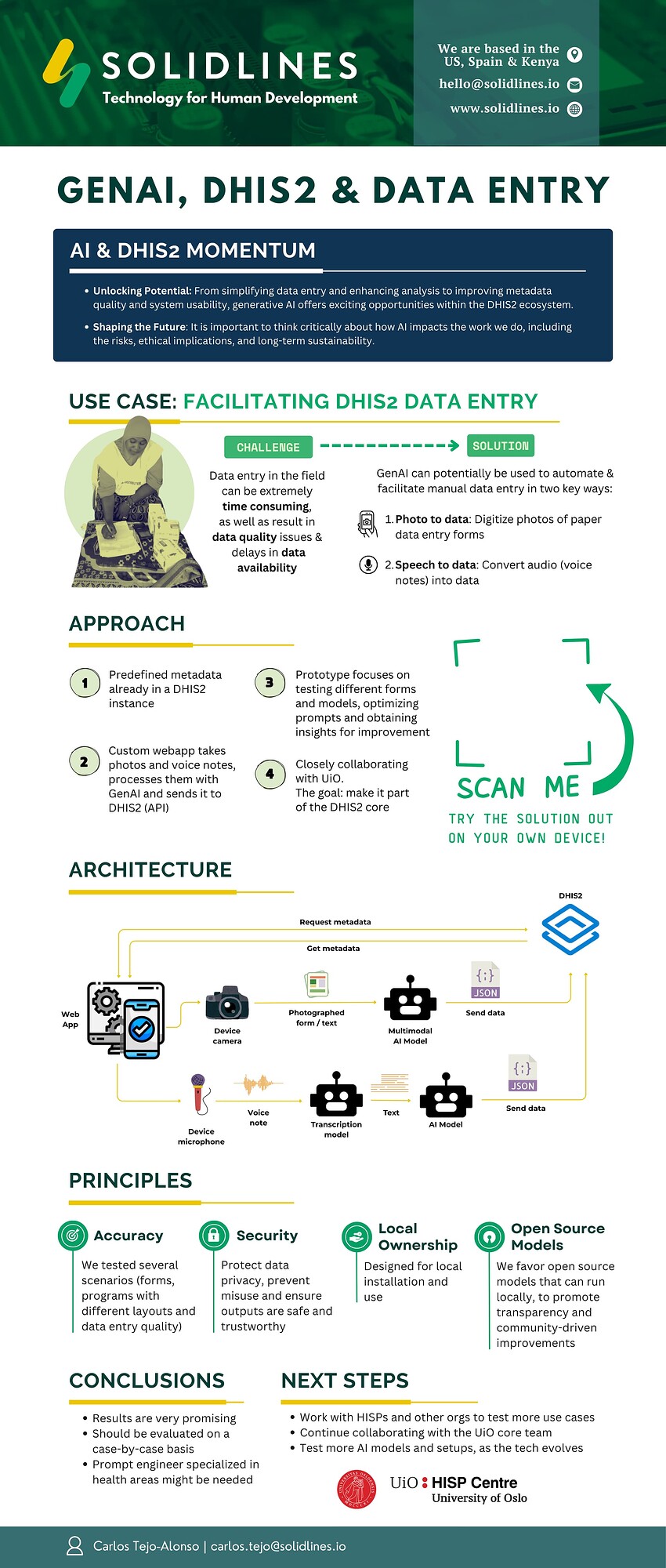This community innovation has been accepted at the 2025 DHIS2 Annual Conference
Digitizing dhis2 data using voice, images and AI / Can AI-supported voice and image processing used with DHIS2 help to overcome the burden of digitizing health data?
Executive summary: This presentation will explore how we can make use of AI services to ingest image and voice data into pre-defined programs/data sets in DHIS2. By harnessing image-to-text and speech-to-text LLMs abilities, we can convert these two modalities into data payloads of DHIS2 programs and have a more automated way of capturing data. This approach could facilitate the speed of data digitalization, allowing data entry users to focus on the quality of these registrations, reviewing and correcting fields when needed. However, these approaches require evaluation and validation in real world contexts and should not be considered a silver bullet. In SolidLines, we have been working during the last 2 years on generative AI-based applications for chatbots in Kenya, South Africa, and India, and we want to bring this world closer to DHIS2. In our presentation, we will share a proof-of-concept to explore this multimodal data capture into DHIS2, and will share our key learnings about combining LLMs with DHIS2. This example will show how AI-assisted tools can streamline data ingestion, allowing users to focus on validating and ensuring data accuracy. We will also share lessons learned from implementation of other AI projects in low resource settings to help inform how DHIS2 and AI assistive tools can be more effectively tested and evaluated with field use cases for iterative improvement of the tools alongside governance and other issues.
Longer description
Most clinics, health centers and community health workers still capture data using paper forms and registries due to a number of limited enabling factors. They are also required to aggregate or transcribe data to a number of additional paper-based mandatory standard reporting forms for upwards reporting to programs, districts or central level. This becomes a time-consuming task, with some studies estimating up to 30% of health care worker time spent on reporting, which means time not spent on delivering health services. Thus, the digitalization of health information has become one of the most burdensome tasks for frontline healthcare workers in the most under-resourced areas. DHIS2 data capture can be very tedious for large volumes of medical data, leading to human errors during the process, and causing significant delays on the decision-making or health responses (specially relevant for surveillance systems, where quick actions are critical). Assisting and smoothening the data capture process can hence have a great impact on data quality and reducing drastically the time needed to digitize the information.
In the last couple of years, we have seen an endless range of applications for Artificial Intelligence (AI) systems. Large Language Models (LLMs) offer a great range of possibilities to handle data in different formats and convert it into structured data. These opportunities can be seized by the DHIS2 capture process to allow the ingestion of data from photos of medical data entry forms or voice notes.
This presentation will explore how we can make use of AI services to ingest image and voice data into pre-defined programs/data sets in DHIS2. By harnessing image-to-text and speech-to-text LLMs abilities, we can convert these two modalities into data payloads of DHIS2 programs and have a more automated way of capturing data. This approach could facilitate the speed of data digitalization, allowing data entry users to focus on the quality of these registrations, reviewing and correcting fields when needed. However, these approaches require evaluation and validation in real world contexts and should not be considered a silver bullet.
In SolidLines, we have been working during the last 2 years on generative AI-based applications for chatbots in Kenya, South Africa, and India, and we want to bring this world closer to DHIS2. In our presentation, we will share a proof-of-concept to explore this multimodal data capture into DHIS2, and will share our key learnings about combining LLMs with DHIS2. This example will show how AI-assisted tools can streamline data ingestion, allowing users to focus on validating and ensuring data accuracy. We will also share lessons learned from implementation of other AI projects in low resource settings to help inform how DHIS2 and AI assistive tools can be more effectively tested and evaluated with field use cases for iterative improvement of the tools alongside governance and other issues.
Primary Author: Amalia Villa
Keywords:
IA, LLM, artificial intelligence, voice, image, digitalization
